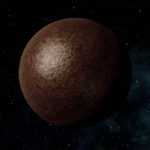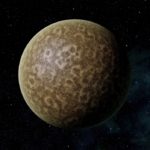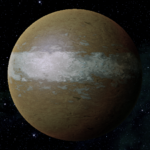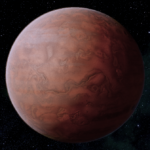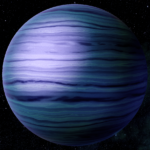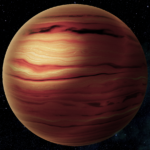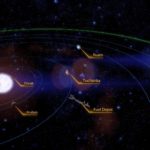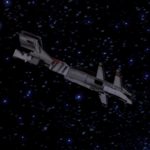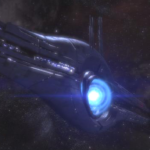System Specs:
- Stellar Mass: 1.7 Sol Masses
- Stellar Class: F
- Luminosity: N/A Sol
- Planets: 6
- Moons: 0
- Asteroid Belts: 1
- Asteroids: 0
- Objects: 2
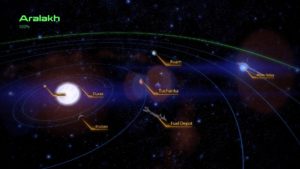
Aralakh is a gateway system. The krogan accord their home star a place of significance in their culture: it means “eye of wrath” in their language, and it lends its name to a place in Tuchanka and an elite warrior unit.
All of Aralakh’s terrestrial worlds are inhospitable; even the krogan homeworld Tuchanka is barely livable by other races’ standards. The Krogan Rebellions saw most resources stripped for the war effort, although there are still some deposits available here and there.
The Council Demilitarization Enforcement Mission (CDEM) maintains a careful watch on krogan hotspots to prevent something like the Rebellions from happening again. Part of their job is regulating helium-3 fuel sales skimmed from the system’s gas giants.
–
Planets Directory:
- Durak
- Kanin
- Kruban
- Tuchanka
- fuel depot
- asteroid belt
- Ruam
- Vaul
- Mass Relay
–
Durak:
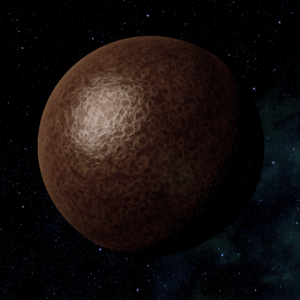
- Orbital Distance: 0.83 AU
- Orbital Period: 0.6 Earth-years
- Keplerian Ratio: 1.588
- Radius: 1,972 km
- Day Length: 8.8 Earth-hours
- Atmospheric Pressure: Trace atm
- Surface Temp: 348 °C
- Surface Gravity: 0.22 g
- Mass: 0.021 Earth-masses
Durak is a small, heat-blasted rock lost in the blinding glare of the star Aralakh. It occasionally traps a trace atmosphere of gases blown in on Aralakh’s powerful solar wind, which inevitably blows the gases back out again.
The planetoid has a few valuable lodes of heavy metals, which were sporadically mined by the krogan at the height of their power. In the closing years of the Rebellions, the five clans working the planetoid fell to fighting over a particularly rich deposit of iridium. All five clan warlords agreed to a Crush (a meeting at a neutral location) to negotiate a truce. Unfortunately, all five arrived planning to betray their fellows. While the leaders and their seconds met, all their bases were destroyed by simultaneous hypervelocity cannon strikes.
Left with only the food, water, and air in their hard-suits, and with no way to call for rescue, the warlords apparently fought each other to the death. The survivors of the five “Durak clans” on Tuchanka still argue about which clan’s warlord was the last one standing.
–
Kanin:
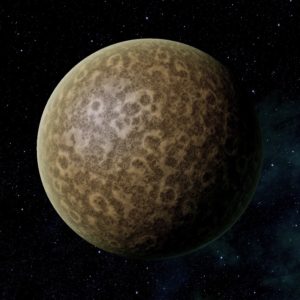
- Orbital Distance: 1.66 AU
- Orbital Period: 1.6 Earth-years
- Keplerian Ratio: 1.787
- Radius: 3,312 km
- Day Length: N/A Earth-hours
- Atmospheric Pressure: Trace atm
- Surface Temp: 155 °C
- Surface Gravity: 0.28 g
- Mass: 0.075 Earth-masses
One of Kanin’s hemispheres contains an impact crater 700 kilometers in diameter. Dubbed the Renkat Basin, it was mined for light metals in the interbellum between the Rachni War and Krogan Rebellions. Any obvious resource concentrations have long since been stripped.
–
Kruban:

- Orbital Distance: 3.31 AU
- Orbital Period: 4.6 Earth-years
- Keplerian Ratio: 1.714
- Radius: 5,443 km
- Day Length: N/A Earth-hours
- Atmospheric Pressure: 47.3 atm
- Surface Temp: 728 °C
- Surface Gravity: 0.7 g
- Mass: 0.506 Earth-masses
Kruban is a tidally-locked Venusian hothouse, its surface perpetually obscured by clouds of sulfur and carbon dioxides. The first group of krogan brought into orbit by the salarian uplift teams requested a trip to Kruban. The salarians at first thought the krogan were confused about the nature of Kruban’s environment; the planet is named for a krogan mythological paradise in which honorable warriors feast on the internal organs of their enemies. In fact, krogan astronomers had correctly deduced the nature of Kruban in the years before the global holocaust. In the two millennia since, Kruban had come to be thought of as an ideal test of one’s toughness.
Every year, a few krogan attempt to land on Kruban and exit their ships naked in an attempt to prove their “kroganhood.” The planet’s surface is littered with the crushed, corroded remains of their ships. Only one, Shath Norda, is known to have returned from the surface alive, albeit with most of his bones crushed and all four of his lungs damaged by sulfuric gas. Norda recovered from his trial, to the adulation of his people. Until he died in 1943, he could lie with any fertile female he wished.
–
Tuchanka:
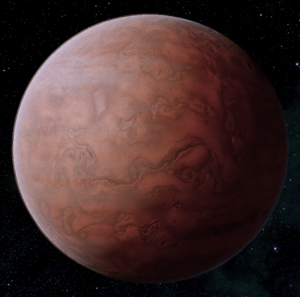
- Orbital Distance: 5.3 AU
- Orbital Period: 16.7 Earth-years
- Keplerian Ratio: 0.534
- Radius: 8,293 km
- Day Length: 21.4 Earth-hours
- Atmospheric Pressure: 1.1 atm
- Surface Temp: 72 °C (36 °C in shrouded areas)
- Surface Gravity: 1.14 g
- Mass: 1.913 Earth-masses
- Homeworld: Krogan
Capital: Urdnot (since 2183), population 2,100,000,000, CDEM Garrison 2,400 (in orbital battle stations)
Scarred by bombardment craters, radioactive rubble, choking ash, salt flats, and alkaline seas, Tuchanka can barely support life. Thousands of years ago, life grew in fierce abundance under the F-class star Aralakh (a Raik clan word meaning “Eye of Wrath”). Tree-analogues grew in thick jungles, their roots growing out of shallow, silty seas. Life fed upon life in an evolutionary crucible. This world died in nuclear firestorms after the krogan split the atom. A “little ice age” of nuclear winter killed off much of the remaining plant life.
In recent centuries, many krogan have returned to their homeworld. The reduced albedo has caused global temperatures to rise. In order to maintain livable temperatures, a vast shroud was assembled at the L1 Lagrange point. It is maintained by the Council Demilitarization Enforcement Mission (CDEM), which is based on orbiting battle stations.
CDEM ADVISORY: Visitors to Tuchanka land at their own risk. The CDEM will not attempt to extract citizens threatened by clan warfare.
TRAVEL ADVISORY: The ecology of Tuchanka is deadly. Nearly every native species engages in some predatory behavior; even the remaining vegetation is carnivorous. Travel beyond guarded areas is strongly discouraged.
Codex Entry
Mass Effect 2
The krogan homeworld boasts extreme temperatures, virulent diseases, and vicious, predatory fauna. Around 1900 BCE, the krogan discovered atomic power and promptly instigated many intraplanetary wars, sending Tuchanka into a nuclear winter. With most of their industrial base destroyed, the krogan entered a new dark age and warring tribal bands dominated. Populations remained low for the next 2000 years.
First contact with the salarians made resurgence possible. Krogan brought to less hostile planets bred exponentially and returned to reconquer their home. They built vast underground shelters to shield themselves from surface radiation, which proved prescient during the Krogan Rebellions when many of them isolated themselves in a vain attempt to avoid the genophage. Convinced they could outbreed the genophage, they transmitted it into more than 90 percent of the sealed bunkers. Today, Tuchanka’s population is sharply limited and while individual krogan are long-lived, the genophage ensures few replacements.
Mass Effect 3
Tuchanka, the krogan homeworld, boasts extreme temperatures, virulent diseases, and predatory fauna. Around 1900 BCE, the krogan discovered atomic weapons and promptly sent their planet into a nuclear winter. The majority of the population retreated to underground bunkers, and krogan culture slipped into a dark age dominated by tribal clans.
In 80 CE, decades into the Rachni Wars, the Salarian Union made first contact with the primitive krogan and initiated a “cultural uplift” to shape them into a modern army capable of confronting the rachni. During this uplift, the salarians constructed the Shroud facility on Tuchanka to shield the planet from harmful forms of solar radiation. Later, during the Krogan Rebellions, reproductive rates were curtailed by the genophage, ensuring the krogan remained a species in decline–and Tuchanka a desolate wasteland.
–
Ruam:
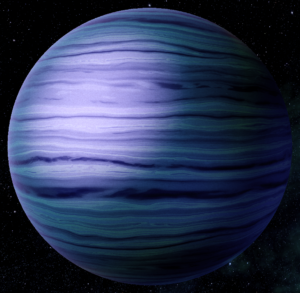
- Orbital Distance: 11.1 AU
- Orbital Period: 28.4 Earth-years
- Keplerian Ratio: 1.696
- Radius: 67,154 km
- Day Length: 13.8 Earth-hours
- Atmospheric Pressure: N/A atm
- Surface Temp: N/A °C
- Surface Gravity: N/A g
- Mass: N/A Earth-masses
- Colony: population 1,040 (CDEM Garrison: 20)
The smaller of Aralakh’s hydrogen-helium gas giants maintains a small helium-3 recovery infrastructure. Although the depth of Ruam’s gravity well makes it inefficient to export, visitors to the Aralakh system often “top off” their fuel tanks at Ruam’s stations. The Council Demilitarization Enforcement Mission (CDEM) maintains a token garrison to monitor any potential sale of fuel to known subversives and terrorists.
–
Vaul:
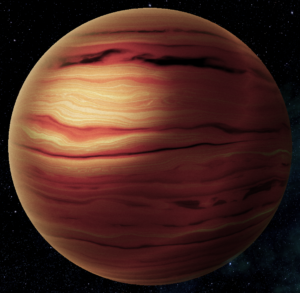
- Orbital Distance: 17.8 AU
- Orbital Period: 57.8 Earth-years
- Keplerian Ratio: 1.688
- Radius: 73,944 km
- Day Length: 12.1 Earth-hours
- Atmospheric Pressure: N/A atm
- Surface Temp: N/A °C
- Surface Gravity: N/A g
- Mass: N/A Earth-masses
- Satellites: >1
Vaul is a hydrogen-helium gas giant named for an ancient krogan deity that stood watch for enemies of his pantheon. The gas giant’s moons are named after some of Vaul’s myriad eyes and ears. The only reason to visit the Vaul system is scientific curiosity, which the krogan lack.
–
–
video

